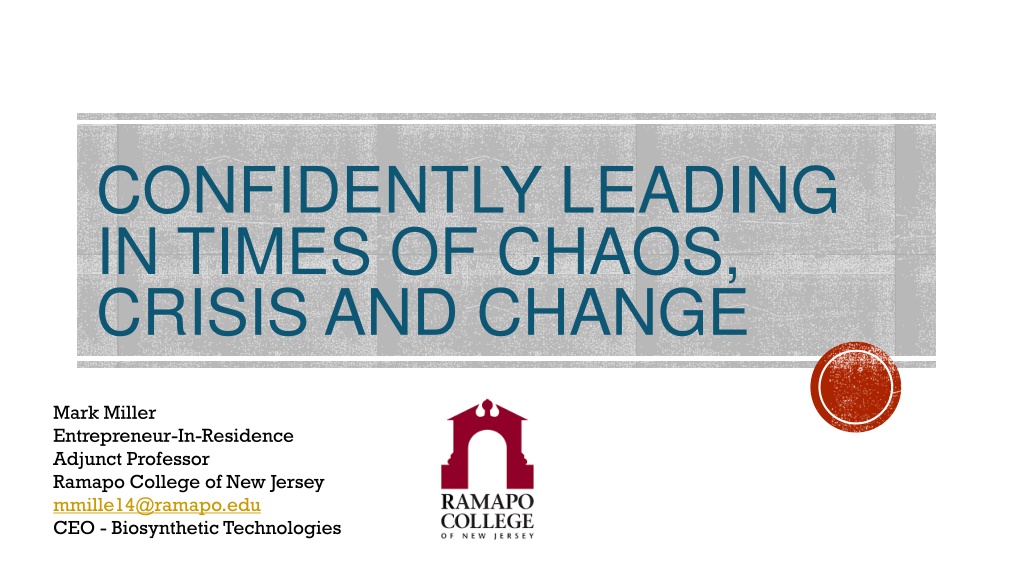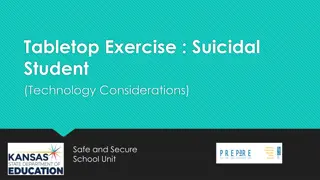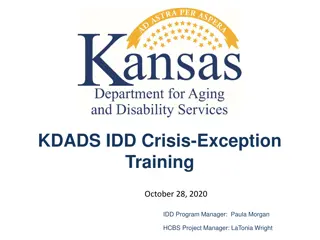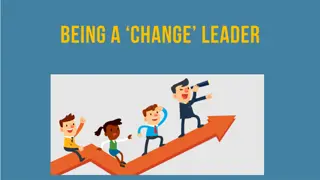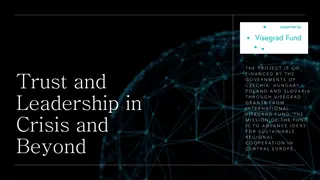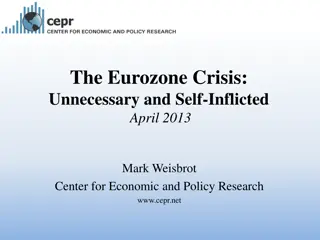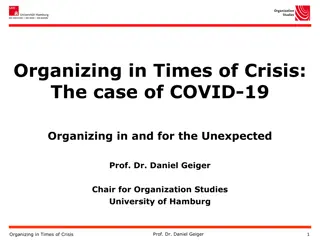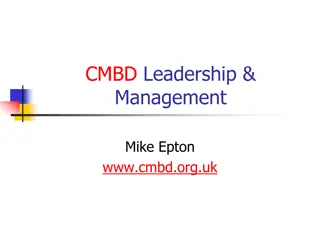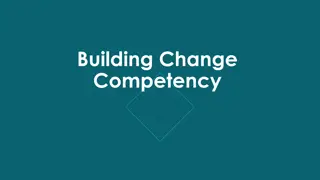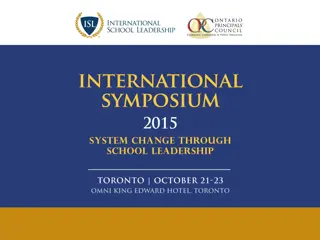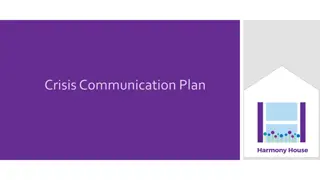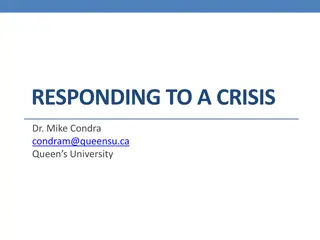Navigating Change and Crisis: Leadership Insights by Mark Miller
Explore valuable insights on confidently leading in times of chaos, crisis, and change with Mark Miller, an experienced entrepreneur and adjunct professor. Learn about sustaining company culture, managing anxiety, and the importance of effective leadership behavior in challenging times.
Download Presentation

Please find below an Image/Link to download the presentation.
The content on the website is provided AS IS for your information and personal use only. It may not be sold, licensed, or shared on other websites without obtaining consent from the author. Download presentation by click this link. If you encounter any issues during the download, it is possible that the publisher has removed the file from their server.
E N D
Presentation Transcript
CONFIDENTLY LEADING IN TIMES OF CHAOS, CRISIS AND CHANGE Mark Miller Entrepreneur-In-Residence Adjunct Professor Ramapo College of New Jersey mmille14@ramapo.edu CEO - Biosynthetic Technologies
OVERVIEW Sustaining Your Culture in Trying Times Resetting the Culture for Service Employee Engagement What Employees Want Reinforcing the Right Behaviors Get Motivated! In Summary
SUSTAINING YOUR CULTURE How you treat people really matters! Must preserve critical intellectual & human capital necessary to keep your business going. Create a High Impact Culture that Improves and Rewards Great Service!
ANXIETY IS ASSOCIATED WITH: Psychological Decreased Commitment Decreased Job Involvement Burnout Behavioral Absenteeism Turnover Accidents Substance Abuse Cognitive Poor Decision Making Lack of Concentration Forgetfulness Physical Cardiovascular System Immune System Gastrointestinal System Anxiety Stress
ANXIETY AND STAKEHOLDERS Anxiety Work Environment Low Anxiety Work Environment Feel Optimistic about future Have enough information to do my job Feel a sense of belonging Can express my opinions without fear Very Favorable Customer Satisfaction Favorable Customer Satisfaction 78% 84% 87% 92% 73% 70% 86% 81% 37% 50% 52% 72%
LEADERSHIP BEHAVIOR MAKES THE DIFFERENCE! Leaders must demonstrate a strong commitment to ethical business practices and fairness. Leaders must think strategically and engage employees in the process. Leaders must provide opportunities for employee development distribute leadership responsibilities. Leaders must recognize performance/achievement timely.
LEADERSHIP BEHAVIOR Leaders throughout the organization must work together to sustain optimism yet be realistic during hard times.
HOW DO LEADERS ACCOMPLISH THAT? Refocus Culture on Service and Commitment & Develop a Plan Provide Employees with Training and Education and opportunities to take on new challenges Offer Incentives for Good Performance Provide Examples of Good Customer Service
LEADERS MUST THINK STRATEGICALLY AND ENGAGE EMPLOYEES IN THE PROCESS. Strategic Thinking is a broader and more innovative way of thinking on a daily basis about the overall goals of your job, team, and organization. It is longer-term oriented with a more systemic and holistic view of your environment. It is also disciplined thinking with a focus first on the desired outcomes of your entire business as a system and then on the relationships between your organizational components along with constant feedback about results to find the leverage points that best achieve your desired outcomes. -Haines Centre for Strategic Management
EMPLOYEE ENGAGEMENT
EMPLOYEE ENGAGEMENT IS KEY Employee engagement first. No company can survive over the long run without energized employees who believe in the mission and understand how to achieve it . Source: Business Week Online: How Healthy Is Your Company?By Jack and Susie Welch.
BENEFITS OF AN ENGAGED WORKFORCE INCLUDE: Retention rates increase, Innovation and collaboration are enhanced, Customer satisfaction levels increase, and Over time, the results are reflected in concrete bottom line results, share value, improve customer relationships and improve and return on investment.
HOW DO WE MEASURE ENGAGEMENT? Employee Engagement: The degree to which employees connect with their work and feel committed to their organization and its goals People who are highly engaged in an activity are: Excited and enthusiastic, Less aware of the passage of time, Devotes discretionary effort , Identifies with the tasks of the job, Thinks about the job activity, High level of Focus, and Openly discusses job with others.
IT ISNT ABOUT THE PAY Maslow s Hierarchy of Needs Physiological needs Safety Love/belonging Esteem Self-Actualization McClelland s Three Needs Theory Affiliation Achievement Authority
TOOLS TO MEASURE ENGAGEMENT Employee Opinion Surveys Engagement Surveys Assessments Focus Groups Employee Meetings What do you use?
TAKE A GOOD LOOK AT YOUR CULTURE. Are you fostering a people culture ? Do you believe your people are your greatest asset? If no, why not?
COMMIT TO DEVELOPING PEOPLE Your results are achieved through the actions of each employee working individually, in teams, across functions. Talent is your competitive advantage today and will be your competitive advantage for the future.
ENSURE THE RIGHT PERSON IS IN THE RIGHT LEADERSHIP POSITION. The best practices way is by measuring the person for JobFit and Leadership Skills with Solid Interviewing Practices and Proven Assessment Tools.
DEVELOP MANAGEMENT STYLES TO FIT YOUR PEOPLE. In today s diverse workforce containing multiple generations and cultures you must rethink your workforce strategies
UNDERSTAND YOUR TARGET EMPLOYEES (CURRENT AND FUTURE). Successful organizations identify their target customer; The time has come to use science, technology and data to identify who is our target employee.
DEVELOP EMPLOYEES PEOPLE SKILLS. Equip your managers with data so they know the basic behavioral tendencies that people have concerning productivity, quality of work, initiative, teamwork, and problem solving.
ENSURE THAT ALL YOUR EMPLOYEES HAVE A GOOD SOLID JOB FIT Research has shown that success on the job has little to do with experience, or education, and everything to do with job fit.
UNDERSTAND WHAT EMPLOYEES EXPERIENCE You work hard to establish your company s brand. Brand creates customer loyalty. You also have a brand where your employees are concerned. Listen Show Compassion Provide Stability Take Steps to Build Trust Provide Hope.
LEADERSHIP TRAITS Leaders must demonstrate a strong commitment to ethical business practices and fairness. Leaders must think strategically and engage employees in the process. Leaders must provide opportunities for employee development. Leaders must recognize performance/achievement timely.
GENERALLY, WHAT DO EMPLOYEES WANT? 25%: Fairness 20%: Challenging Work 16%: Camaraderie 13%: Pay 13%: Work/life Balance 10%: Development 3%: Benefits Sirota Survey Intelligence study
HOW TO IMPROVE RETENTION IN A TOUGH ECONOMY Communicate with employees openly and often. Show compassion. Foster adaptation; anticipate & address employee/customer questions. Be honest and proactive with employees about your organization s financial health and its business plans. Establish clear communication, expectations and priorities. Ask employees for cost-savings and business improvement ideas. Strive to retain the current culture: retain the low-cost/high impact touches in your workplace from providing quality coffee to company picnics. Embrace disequilibrium. Focus on individual achievement and development-generate leadership.
A FEW MORE TAKEAWAYS Work to sustain the Corporate Culture. Take Steps to Actively Engage the Workforce. Support and Acknowledge Needs and Reward and Recognize the Right Behaviors . Through understanding needs, keep the A players understand needs, focus on development, feedback and communication empower employees to make things happen . Using surveys, asking questions, & provide employees the opportunity to participate in making improvements and being part of programs. Treat employees like family. Show Compassion. And they will treat others the same!d self care .
